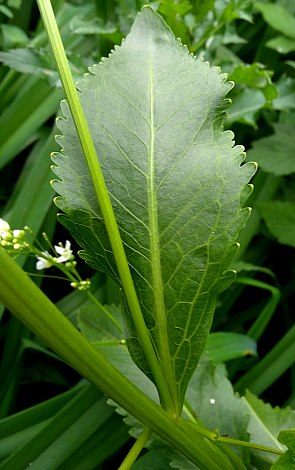
The central stem and upper axillary stems terminate in either racemes or panicles of flowers about 4-16" in length. The flowers bloom toward the apex of each raceme (or branch of a panicle), while seedpods develop below. Each flower spans about 1/3" (8 mm.) across, consisting of 4 white petals, 4 light green sepals, 6 stamens, and a pistil with a short style. The petals are about twice the length of the sepals. The ascending pedicels are ¼-¾" in length, light green, and glabrous, becoming longer as the seedpods develop. The central stalks and branches of the racemes and panicles are light green and glabrous. The blooming period can occur from mid-spring to mid-summer and lasts about 2 months. The flowers are replaced by cylindrical seedpods up to ¼" (6 mm.) long; each seedpod can contain up to 8 seeds. The root system consists of a stout taproot and stout rhizomes. Clonal colonies of plants are often produced.

Cultivation: The preference is full or partial sun, moist conditions, and fertile soil containing loam or silt-loam. Because of its underground rhizomes, Horseradish can spread aggressively.
Range & Habitat: The non-native Horseradish is occasional in most areas of Illinois, except in the SE section of the state, where it is rare or absent (see Distribution Map). This plant was introduced into North America from Europe during colonial times; it is native to SE Europe and parts of SW Asia. Habitats include streambanks, ditches, fence rows, low areas along roads and railroads, abandoned fields, vacant lots, disturbed open woodlands, and waste areas. Horseradish is still cultivated in gardens as a culinary herb. It is usually found in disturbed areas.

Faunal Associations: The nectar and pollen of the flowers attract small bees, flies, small butterflies, and probably other insects. Several leaf beetles (Chrysomelidae) have been observed to feed on Horseradish, specifically: Entomoscelis americana, Phaedon laevigatus, Phyllotreta armoraciae (Horseradish Flea Beetle), Phyllotreta bipustulata, Phyllotreta conjuncta, Phyllotreta cruciferae, Phyllotreta oblonga, Phyllotreta punctulata, Phyllotreta striolata, and Phyllotreta zimmermanni (see Clark et al., 2004). These species are mostly flea beetles (a subfamily of leaf beetles) that feed on the foliage and sometimes the roots. Other insect feeders include Murgantia histrionica (Harlequin Bug), the caterpillars of Lascoria ambigualis (Ambiguous Moth), and the caterpillars of Pieris rapae (Cabbage White). Because of high levels of mustard oil from the conversion of glucosinolates, Horseradish can produce toxic effects on mammalian herbivores, especially the pungent roots.
Photographic Location: A roadside ditch in NW Ohio, and the Toledo Botanical Garden in Toledo, Ohio.

Comments: In the United States, the thick roots of Horseradish are grated to flavor various sauces for food (primarily dishes of beef, pork, and seafood). Such sauces usually contain vinegar, mayonnaise, or pureed tomatoes. Because of the warm climate during summer and the long growing-season, Horseradish usually produces both seedpods and viable seeds in Illinois and other areas of the lower Midwest. Apparently this rarely happens in Great Britain and other areas of Europe where the climate is cool and the growing-season is too short. However, Horseradish is readily propagated by dividing its roots. Because of the size and abundance of its flowers, Horseradish is fairly showy while it is in bloom, especially for a species in the Mustard family. It is also larger in size than most species in this plant family. Horseradish can be distinguished from similar species by the size of its white flowers (about 1/3" or 8 mm. across), the appearance of its basal and alternate leaves, its small cylindrical seedpods, and the pungent odor of its roots. Because the classification of Horseradish has been unstable in the past, it is sometimes referred to as Armoracia lapathifolia, Cochlearia armoracia, and Rorippa armoracia.